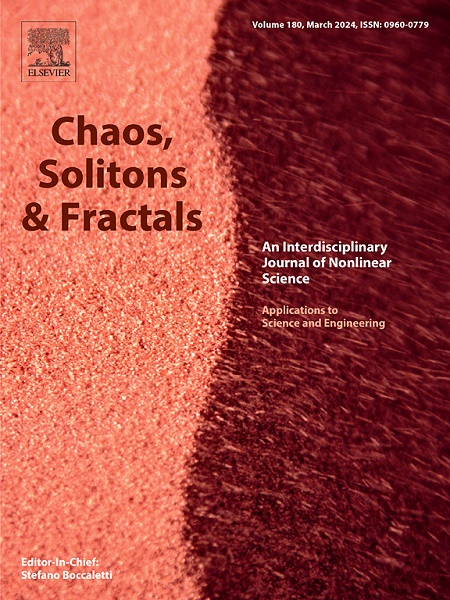基于全记忆元件仿真器的仿生电路的动态行为和发射模式
IF 5.6
1区 数学
Q1 MATHEMATICS, INTERDISCIPLINARY APPLICATIONS
引用次数: 0
摘要
基于记忆元件的仿生电路可以很好地表征生物神经元的电生理行为,并产生丰富的神经元样放电模式。本文利用电荷控制的记忆电容、电压控制的直流偏压局部有源记忆电阻(LAM)、磁控记忆电感器和正弦刺激分别表征神经元膜、离子通道、电磁感应和外部刺激,构建了基于全记忆元件仿真器的仿生电路。数值模拟表明,仿生电路通过电路参数的正向/反向倍周期分岔路线、正切分岔和混沌危机实现了多种模式转换行为,从而触发周期和混沌尖峰活动等多种放电模式。此外,利用记忆元件仿真器成功合成了一个采用离散元件的硬件电路,并进行了实验测量,以支持数值结果,并证明了仿生电路产生类神经元放电模式的能力。本文章由计算机程序翻译,如有差异,请以英文原文为准。
Dynamical behaviors and firing patterns in a fully memory-element emulator-based bionic circuit
Memory-element-based bionic circuits can well characterize the electrophysiological behavior of a biological neuron and generate abundant neuron-like firing patterns. This paper deploys a charge-controlled memcapacitor, a voltage-controlled locally active memristor (LAM) with one DC voltage bias, a flux-controlled meminductor, and a sinusoidal stimulus to respectively characterize the neuronal membrane, ion channel, electromagnetic induction, and external stimulus, thereby a fully memory-element emulator-based bionic circuit is constructed. Numerical simulations demonstrate that the bionic circuit achieves diverse pattern transition behaviors through the forward/reverse period-doubling bifurcation routes, tangent bifurcation, and chaos crisis for the circuit parameters, which trigger diverse firing patterns, e.g., periodic and chaotic spiking activities. Besides, a hardware circuit using discrete components is successfully synthesized by memory-element emulators, and experimental measurements are carried out to support the numerical results and demonstrate the capability of the bionic circuit to produce neuron-like firing patterns.
求助全文
通过发布文献求助,成功后即可免费获取论文全文。
去求助
来源期刊

Chaos Solitons & Fractals
物理-数学跨学科应用
CiteScore
13.20
自引率
10.30%
发文量
1087
审稿时长
9 months
期刊介绍:
Chaos, Solitons & Fractals strives to establish itself as a premier journal in the interdisciplinary realm of Nonlinear Science, Non-equilibrium, and Complex Phenomena. It welcomes submissions covering a broad spectrum of topics within this field, including dynamics, non-equilibrium processes in physics, chemistry, and geophysics, complex matter and networks, mathematical models, computational biology, applications to quantum and mesoscopic phenomena, fluctuations and random processes, self-organization, and social phenomena.
 求助内容:
求助内容: 应助结果提醒方式:
应助结果提醒方式:


